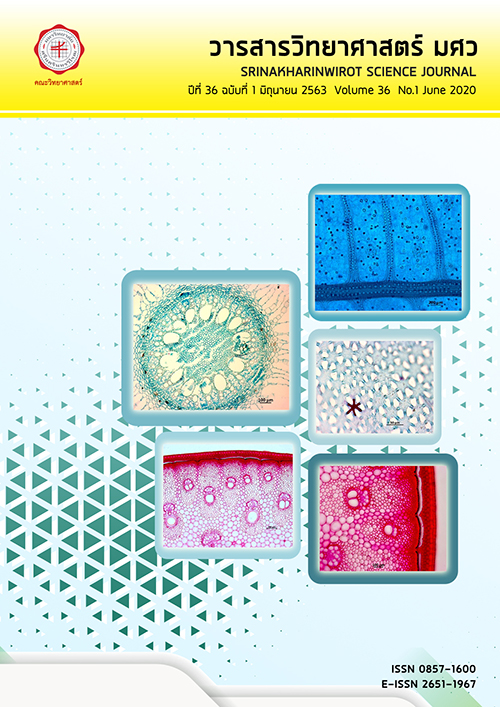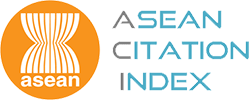Small-Scaled Analysis for Amylose Content in Brown Rice and Thai Rice Clustering based on Amylose Content
Keywords:
การวิเคราะห์จัดกลุ่ม, แอมิโลส, ข้าวไทย, Cluster analysis, Amylose, Thai riceAbstract
บทคัดย่อ ข้าว (Oryza sativa L.) เป็นพืชที่มีการปลูกอย่างแพร่หลายในภูมิภาคต่างๆ ของประเทศไทย ทำให้ประเทศไทยเป็นแหล่งพันธุกรรมของแป้งข้าวลักษณะต่างๆ การศึกษานี้มีวัตถุประสงค์เพื่อพัฒนาวิธีวิเคราะห์ปริมาณแอมิโลสโดยใช้เนื้อเยื่อปริมาณน้อยและนำข้อมูลปริมาณแอมิโลสมาใช้ในการจัดกลุ่มพันธุ์ข้าวไทยจำนวน 100 พันธุ์ที่จากภูมิภาคต่างๆ ของประเทศไทย การใช้ตัวอย่างข้าวลดลง 5 เท่าจากวิธีดั้งเดิมสามารถใช้ในการวิเคราะห์ปริมาณแอมิโลสได้และการอ่านค่าด้วยไมโครเพลทรีดเดอร์ได้ เมื่อทำการวิเคราะห์ปริมาณแอมิโลส พบว่าปริมาณแอมิโลสในข้าวพันธุ์ต่างๆ มีความแตกต่างกันอย่างมีนัยสำคัญทางสถิติ อยู่ในช่วงร้อยละ 7.04 ถึง 32.73 ข้าวพันธุ์เอวมดแดงมีปริมาณแอมิโลสสูงที่สุด ในขณะที่ข้าวพันธุ์ก่ำเมืองน่านมีปริมาณแอมิโลสต่ำที่สุด ผลการวิเคราะห์ปริมาณแอมิโลสในข้าวกล้องสามารถแบ่งกลุ่มข้าวเป็น 4 กลุ่ม ได้แก่ ข้าวเหนียวที่มีปริมาณแอมิโลสต่ำ ข้าวเจ้าที่มีปริมาณแอมิโลสต่ำ ข้าวเจ้าที่มีปริมาณแอมิโลสปานกลางและข้าวเจ้าที่มีปริมาณแอมิโลสสูงตามลำดับ ข้าวเหนียวพบมากในพบในภาคกลางและภาคตะวันออก ข้อมูลจากการวิจัยนี้สามารถนำไปใช้เป็นข้อมูลพื้นฐานในการพัฒนาพันธุ์ข้าวที่มีสมบัติแป้งที่จำเพาะต่อไปได้ ABSTRACT Rice (Oryza sativa L.) is plant which distributes throughout Thailand. These represent the collection of genetic resources for starch characteristics in rice grains. This research aims to develop small-scaled quantifying method for amylose content determination in rice grains and to use the amylose content for cluster analysis of 100 Thai rice cultivars distributed throughout Thailand. Five-fold reduction in rice grain weight compared to the original method could be used for amylose content measurement. This method could be applied to use microplate reader for quantification in order to analyze a large number of samples. Rice grains were used for amylose content determination. The amylose contents in various cultivars were significantly different and ranged from 7.04-32.73%. ‘Aew Mod Daeng’ rice had the highest amylose content, while ‘Gam Meuang Nahn’ rice showed the lowest amylose. When amylose content was subjected to cluster analysis, these cultivars could be separated into 4 groups, which were sticky rice with low amylose content, rice with low amylose content, rice with intermediate amylose content and rice with high amylose content. Sticky rice cultivars were found in the northern and the upper northeastern of Thailand, while most of rice cultivars were rice with intermediate amylose content and the majority was found in the central and the eastern part of Thailand. This information can be used for breeding program to develop the new cultivar with specific starch characteristics.Downloads
Download data is not yet available.
Downloads
Published
2020-06-26
How to Cite
Praphasanobol, P., Kasettranun, W., Paliyavuth, C., Chanbuathong, S., Chotechuen, S., Moung-Ngam, P., Wasusun, A., & Chadchawan, S. (2020). Small-Scaled Analysis for Amylose Content in Brown Rice and Thai Rice Clustering based on Amylose Content. Science Essence Journal, 36(1), 75–94. Retrieved from https://ejournals.swu.ac.th/index.php/sej/article/view/11170
Issue
Section
พฤกษศาสตร์แห่งประเทศไทย ครั้งที่ 13(ปิดรับ)








